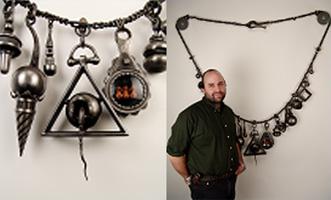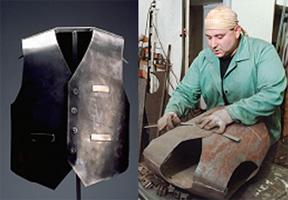Contributing Writer
- FMA
- The Fabricator
- FABTECH
- Canadian Metalworking
Categories
- Additive Manufacturing
- Aluminum Welding
- Arc Welding
- Assembly and Joining
- Automation and Robotics
- Bending and Forming
- Consumables
- Cutting and Weld Prep
- Electric Vehicles
- En Español
- Finishing
- Hydroforming
- Laser Cutting
- Laser Welding
- Machining
- Manufacturing Software
- Materials Handling
- Metals/Materials
- Oxyfuel Cutting
- Plasma Cutting
- Power Tools
- Punching and Other Holemaking
- Roll Forming
- Safety
- Sawing
- Shearing
- Shop Management
- Testing and Measuring
- Tube and Pipe Fabrication
- Tube and Pipe Production
- Waterjet Cutting
Industry Directory
Webcasts
Podcasts
FAB 40
Advertise
Subscribe
Account Login
Search
Larger-than-life objects equal memorable sculptures
- By Dona Z. Meilach
- March 8, 2005
- Article
- Arc Welding
 |
| Figure 1 Marc Mullin stands between two of his sculptures, "Gaceful Lily" and "Sultry Lily," 68 in. high, 28 in. wide. Photo by Richard Nicol. |
Such is the case with the three artists whose works are shown here. They make recognizable objects that take on new character because of their size.
Marc Mullin's Flower Power
When I first saw Marc Mullin's "Graceful Lily" sculpture in a photo, I thought it was well done. But when he sent me a photo of himself standing next to two flowers, I knew he was on to something big. Mullin, of Seattle, Wash., blends traditional blacksmithing techniques and contemporary TIG welding methods to create his distinctive metal sculptures.
The two lily sculptures shown in Figure 1 are forged and fabricated mild steel pieces accented with copper elements. Each hand-forged part is designed to create a sense of character or sentiment, a sense of soul as it is being transformed from its natural rugged state into a final piece. Individual parts are carefully TIG welded together, followed with curving wraps to emulate life-size lilies that stand approximately 69 in. tall.
Mullin's primary medium of choice is metal because of its versatility. He said,
"The infinite potential of metal often acts as a catalyst for incorporating secondary mediums in my designs." The idea of transforming rugged raw materials into beautiful elegance is the motivator behind his creative process. Optimally, his goal is to produce work that has been transformed through a symbiotic process of craft and inspiration into a soulful, almost sensual piece of art.
Mullin, born in Naples, Italy, cultivated an early appreciation of organic forms and art nouveau styles that are apparent in his sculpture, furniture, and accessories.
Adam Clark's Larger-Than-Life Jewelry
Just as Mullin's lilies fooled me by their size, Adam Clark's necklace, shown in Figure 2, required a double take. I admired his ability to fashion each ironwork bauble so precisely. But in the photo of him standing in front of the necklace (see Figure 3), the scale made the piece jump to life.
 |
| Figure 2 and Figure 3 Adam Clark's iron "beads" are inventive elements in his 6-foot-high sculptural necklace. |
Clark works and teaches in San Francisco. Originally trained as a jewelrymaker, he sometimes has trouble defining why he works small items to a large scale. He said, "I don't fully connect to the way in which jewelry is presented, judged, and valued. It is an art form dominated heavily by its preciousness and commercial appeal. The artier work seems to center on proving its worth compared to accepted art forms. Perhaps all I am doing with this series of work is a cheap trick. Do I simply make jewelry larger and call it sculpture? Maybe I am defending the jewelers' position that they don't receive the respect they deserve due to the scale of their work. It could even be that I am mocking their inability to move beyond their money-driven neuroses."
Clark explained that he doesn't really plan his work; it just happens. "I start making things, look at them, and get a vision of what I want to make. I can analyze what I make after I make it and try to find relevance, but it gets complex. Making sculpture is pure leisure compared to making items for a specific marketplace or commission."
Adam Clark's iron "beads" are inventive elements in his 6-foot-high sculptural necklace.
Invest in Strength – Raymond Miller
More larger-than-life memorable sculptures are the pieces of wearing apparel pieces fabricated by Raymond Miller of Cincinnati, Ohio. Miller, adjunct assistant professor of mechanical engineering at the University of Cincinnati's College of Applied Science, also is a dedicated sculptor who has earned several prizes in sculpture shows.
Often engineers don't make good sculptors, but Miller is an exception. He said, "When I entered engineering school [as an undergraduate] ... I was a lab assistant making lab apparatus. I had to make lots of things using machine tools and welding, and I really enjoyed it. I teased my dad that I'd be doing it full-time, except that he forced me to go to college," recalled Miller, who began teaching at Cincinnati's College of Applied Science in 1987.
When an early job required extensive travel, Miller satisfied his creative urge by making leather items in hotel rooms. A change of jobs meant more time at home and an opportunity to extend his creative reach. He knew he wanted to sculpt, but he didn't know how to start. Leatherwork was too limiting. His move to the college as an adjunct changed that.
 |
| Figure 4 and Figure 5 "Invest in Strength" by Raymond Miller, 12 in. deep, 18 in. wide, 60 in. high. |
There he began teaching principles of manufacturing labs and lectures. Then in the summer of 1994, Miller asked the mechanical engineering program director if he could use the welding area to weld scrap metal. The director said, "Sure. You're a faculty member here." Miller then asked an artist friend to teach him what he knew. After two visits, the friend said, "You don't need me."
That first summer Miller created about 20 sculptures of neckties, collars, shirts, and suit vests. He actually used a McCall's fashion pattern for the vest in a size 48, his size at the time. Pattern parts were cut out with a band saw. Heat, hammering, and TIG welding all were put to good use. Washers were used for buttons.
Miller's clothing series were "power" symbols. He reasoned that the power elite wears ties and suits and often vests. He philosophically determined that, in the past, the power elite wore armor; today, instead of armor, they wear Armani. Miller's work "Invest in Strength" (see Figures 4 and 5) won the grand prize at the Cleveland Sculpture Center's juried exhibit in 1996.
Being a sculptor isn't an easy career path, so Miller began to concentrate on functional work for interior designers. Now his two disciplines often merge. He even made an extra-large metal jail cell to use in a commercial for the telephone company.
If you're looking for an attention-getting, creative way to use metal, think real objects—but make them larger than life.
The artists mentioned in this article can be reached at:
Marc Mullin - www.mrmmetalart.com
Adam Clark- monkeyshinemtl@earthlink.net
Raymond Miller - millerra@uc.edu
About the Author
Dona Z. Meilach
760-436-4395
About the Publication
subscribe now

The Welder, formerly known as Practical Welding Today, is a showcase of the real people who make the products we use and work with every day. This magazine has served the welding community in North America well for more than 20 years.
start your free subscription- Stay connected from anywhere

Easily access valuable industry resources now with full access to the digital edition of The Fabricator.

Easily access valuable industry resources now with full access to the digital edition of The Welder.

Easily access valuable industry resources now with full access to the digital edition of The Tube and Pipe Journal.
- Podcasting
- Podcast:
- The Fabricator Podcast
- Published:
- 04/16/2024
- Running Time:
- 63:29
In this episode of The Fabricator Podcast, Caleb Chamberlain, co-founder and CEO of OSH Cut, discusses his company’s...
- Trending Articles
Sheffield Forgemasters makes global leap in welding technology

ESAB unveils Texas facility renovation

Engine-driven welding machines include integrated air compressors

The impact of sine and square waves in aluminum AC welding, Part I

Compact weld camera monitors TIG, plasma processes

- Industry Events
16th Annual Safety Conference
- April 30 - May 1, 2024
- Elgin,
Pipe and Tube Conference
- May 21 - 22, 2024
- Omaha, NE
World-Class Roll Forming Workshop
- June 5 - 6, 2024
- Louisville, KY
Advanced Laser Application Workshop
- June 25 - 27, 2024
- Novi, MI


























